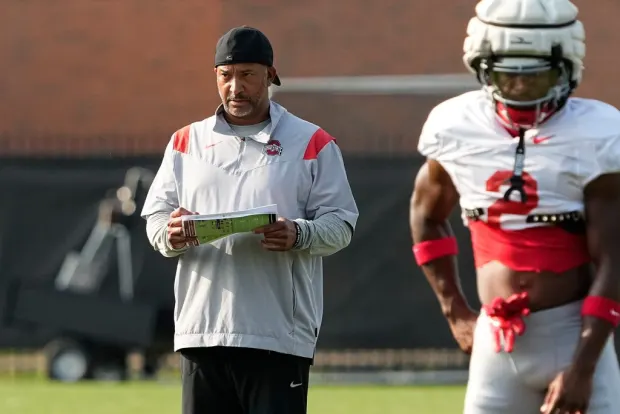Ohio State Buckeyes lose stud recruiting target to another Big Ten school who they would have been thrilled to add

The Ohio State Buckeyes have long been a powerhouse in college football recruiting, consistently securing some of the nation’s most elite high school talent. With their storied program, top-tier coaching staff, and a tradition of producing NFL stars, Ohio State is often the dream destination for many top recruits. So when a stud recruiting target emerges on their radar, the Buckeyes and their fans can’t help but get excited about the possibilities. However, in a recent and somewhat surprising turn of events, Ohio State has lost a major recruiting target—not to an out-of-conference team or a smaller program, but to another Big Ten school. And not just any Big Ten school, but one that Ohio State would have been absolutely thrilled to add to their roster.
This kind of recruiting loss stings on multiple levels. First, there’s the obvious disappointment of losing a player who had the potential to make an immediate and lasting impact on the Buckeyes’ roster. Second, and perhaps even more significant, is the fact that this recruit chose a direct competitor within the same conference. It’s the kind of shift that can ripple through recruiting cycles, altering the balance of power within the Big Ten, at least on paper.
For years, Ohio State has dominated recruiting battles in the Big Ten. Their combination of high-profile national exposure, elite facilities, and a proven pathway to professional football has given them an edge over most rivals. So, when this particular recruit—a stud athlete who was considered a perfect fit for Ohio State’s system and culture—opted for another Big Ten school, it sent shockwaves through the Buckeyes’ fanbase and coaching staff alike.
The recruit in question, a high-impact player who was ranked among the nation’s top prospects, had drawn significant attention for his athleticism, football IQ, and versatility on the field. His recruitment was viewed as a top priority for Ohio State’s coaching staff, who envisioned him contributing immediately on both offense and defense, depending on the scheme. Scouting reports highlighted his ability to make explosive plays, his leadership qualities, and his relentless work ethic—attributes that fit perfectly with the Buckeyes’ competitive culture.
Ohio State’s offer was on the table early and accompanied by the full weight of the program’s recruiting machinery: extensive campus visits, meetings with key coaching staff, tours of the facilities, and an immersive experience of Buckeye Nation’s storied football culture. The coaching staff had high hopes that their pitch would be persuasive enough to secure his commitment well before the national signing day deadline.
But despite all the effort and the obvious appeal of Ohio State’s program, the recruit surprised many by committing to a rival Big Ten program that has been steadily rising in prominence. This school, while not traditionally considered a recruiting juggernaut on the level of Ohio State, has made significant strides in recent years—improving its coaching staff, upgrading its facilities, and cultivating a new identity that appeals strongly to top-level recruits looking for a competitive but perhaps less pressure-filled environment.
The decision to join this rival school rather than Ohio State was influenced by several factors. First, the recruit expressed a strong connection to the coaching staff at the other Big Ten program. Relationships in recruiting cannot be overstated, and this recruit repeatedly mentioned how the coaches made him feel valued, understood his aspirations, and laid out a clear developmental plan that resonated with his personal and athletic goals. The sense of trust and mutual respect was a decisive element.
Second, the recruit appreciated the opportunity to be a cornerstone player in a program on the rise. While Ohio State boasts a loaded roster with intense competition for playing time, the other school offered him the chance to step in as an immediate impact player, a potential game-changer who could help accelerate the program’s ascent within the conference hierarchy. This promise of a leadership role and the ability to help shape the future of the team was a compelling draw.
Third, geographic and familial considerations played a subtle but significant role. The recruit’s decision factored in proximity to home, the comfort of the campus community, and a sense of belonging that extended beyond the football field. While Ohio State’s program is undeniably prestigious, the atmosphere and environment at the rival school felt like a better fit for the recruit’s overall well-being and long-term happiness.
The impact of this commitment reverberated immediately. Ohio State fans and analysts took notice, expressing a mixture of surprise and frustration. Losing a recruit of this caliber to a conference rival not only meant missing out on a potential game-changer but also seeing that player potentially contribute to beating the Buckeyes on the field in the future.
For the rival Big Ten school, however, this commitment was a massive recruiting victory. It validated their recent program investments and showed prospective recruits that they could compete with even the most storied programs in the conference. This signing helped to elevate the program’s national profile and sent a message that their trajectory is upward, that they are a destination for top-tier talent, and that they have the vision and resources to build a contender.
Ohio State’s recruiting staff now faces a crucial challenge. The loss of this recruit underscores the increasingly competitive landscape of college football recruiting, even within conferences. It sends a reminder that the Buckeyes cannot take any commitment for granted, even from those who seem like perfect fits. It also highlights the importance of relationship-building and understanding the full range of factors that influence a recruit’s decision—not just program prestige and history, but personal connections, role opportunities, and environment.
The coaching staff will likely regroup, refine their recruiting approach, and redouble efforts to secure commitments from other top-tier prospects. This setback could serve as a catalyst for reassessment, prompting Ohio State to identify new ways to distinguish themselves beyond their traditional advantages. Whether it’s doubling down on player development, emphasizing unique aspects of their culture, or improving their outreach and relationship-building, the Buckeyes must ensure that future recruits see Ohio State not only as a destination of tradition but also as a place where their individual journey will be maximized.
For the recruit, the decision marks the beginning of an exciting new chapter. Choosing a school that offers both competitive opportunity and a supportive environment sets the stage for personal and athletic growth. His commitment will attract additional talent to his new program, as other prospects often follow top recruits to rising teams. His success on the field will be closely watched by Buckeyes fans who can’t help but wonder what might have been had he chosen Ohio State.
This recruiting drama serves as a microcosm of the ever-evolving dynamics within college football. Programs are constantly jockeying for position, not just on the field but in the hearts and minds of young athletes who hold the keys to their future success. The Big Ten, once dominated by a few powerhouse programs, is seeing a broader distribution of talent, with more schools able to compete for—and secure—high-caliber recruits.
Ohio State remains one of the premier programs in the nation, with a legacy that few can match. But the loss of this stud recruit to a fellow Big Ten school is a reminder that even the most prestigious programs must continue to innovate, connect, and fight to maintain their elite status in recruiting battles. The days when Ohio State could assume top recruits would naturally choose the scarlet and gray may be fading, replaced by a more competitive and dynamic landscape.
In the end, this development could ultimately benefit the Big Ten as a whole. Increased competition for recruits helps raise the overall level of play within the conference, leading to more exciting games, greater national attention, and enhanced opportunities for all involved. For the fans, the drama of recruiting battles and unexpected commitments adds another layer of intrigue to the college football narrative.
As Ohio State moves forward, their staff and supporters will no doubt take this recruiting loss to heart, using it as fuel to push harder and smarter in the future. The desire to bring elite talent to Columbus remains as strong as ever, and while this particular recruit chose another path, the Buckeyes’ relentless pursuit of excellence will continue. The program’s commitment to competing at the highest level means they will learn from every setback and remain a force to be reckoned with in the Big Ten and beyond.
Recruiting battles are never easy, and no player’s decision is made lightly. But when a top target opts for a direct conference rival, the stakes are raised, the disappointment is sharper, and the implications are broader. Ohio State’s recent loss is a vivid example of the complexities of college football recruiting in today’s landscape—where personal fit, coaching relationships, and the promise of opportunity can sometimes outweigh tradition and prestige.
While the Buckeyes undoubtedly hoped to add this stud recruit to their roster, his commitment elsewhere only adds fuel to the competitive fire that makes college football recruiting one of the most captivating—and unpredictable—aspects of the sport. Ohio State’s quest for greatness continues, fueled by determination, resilience, and the ongoing battle to attract the very best players who will carry the program’s legacy into the future.





